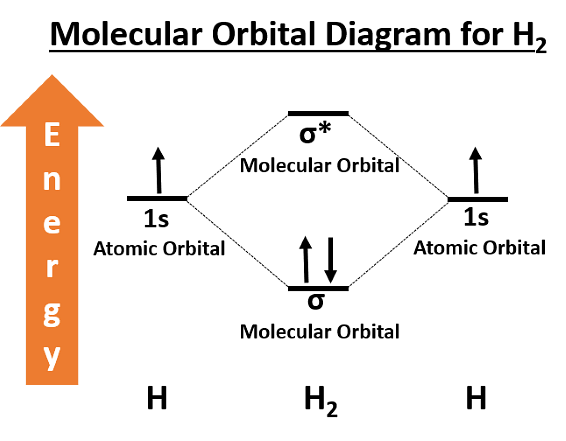The wave functions of $1s$ orbitals of two hydrogen atoms are $\Psi_A$ and $\Psi_B$. $\Psi_A$ and $\Psi_B$ are linearly combined to form two molecular orbitals ($\sigma$ and $\sigma^{\ast}$). Which of the following statements are collect?
I. $\sigma^{*}$ is equal to $(\Psi_{A}-\Psi_{B})$.
II. In $\sigma$ - orbital, one nodal plane is present in between two nuclei.
III. The energy of $\sigma$ - orbital is lower than the energy of $\sigma^{*}$ -orbital.
- I ,II ,III
- I, II only
- II, III only
- I, III only
The Correct Option is D
Solution and Explanation
I. $\sigma^{*}$ -orbital are formed by the substraction of two wave functions say $\psi_{A}$ and $\psi_{B}$ and therefore $\sigma^{*}=\psi_{A}-\psi_{B}$
II. $\sigma$-orbital are formed when two orbitals are in same phase and thus, do not have nodal plane in between two nuclei.
III. Combination of two sigma $(\sigma)$ atomic orbitals given two molecular orbitals, out of which one is of lower energy called $\sigma$ bonding orbital and other is of higher energy called $\sigma^{*}$ anti-bonding orbital.
Hence, (i) and (iii) are the correct statements
Top Questions on Molecular Orbital Theory
- In the following, the number of paramagnetic molecules are: O\(_2\), N\(_2\), F\(_2\), B\(_2\), Cl\(_2\).
- JEE Main - 2025
- Chemistry
- Molecular Orbital Theory
Which of the following statement is true with respect to H\(_2\)O, NH\(_3\) and CH\(_4\)?
(A) The central atoms of all the molecules are sp\(^3\) hybridized.
(B) The H–O–H, H–N–H and H–C–H angles in the above molecules are 104.5°, 107.5° and 109.5° respectively.
(C) The increasing order of dipole moment is CH\(_4\)<NH\(_3\)<H\(_2\)O.
(D) Both H\(_2\)O and NH\(_3\) are Lewis acids and CH\(_4\) is a Lewis base.
(E) A solution of NH\(_3\) in H\(_2\)O is basic. In this solution NH\(_3\) and H\(_2\)O act as Lowry-Bronsted acid and base respectively.
- JEE Main - 2025
- Chemistry
- Molecular Orbital Theory
Which of the following linear combinations of atomic orbitals will lead to the formation of molecular orbitals in homonuclear diatomic molecules (internuclear axis in z-direction)?
(1) \( 2p_z \) and \( 2p_x \)
(2) \( 2s \) and \( 2p_x \)
(3) \( 3d_{xy} \) and \( 3d_{x^2-y^2} \)
(4) \( 2s \) and \( 2p_z \)
(5) \( 2p_z \) and \( 3d_{x^2-y^2} \)
- JEE Main - 2025
- Chemistry
- Molecular Orbital Theory
- Arrange the following in increasing order of bond order: (A) He\(_2^+\)
(B) O\(_2^-\)
(C) HF
(D) NO\(^-\)- CUET (PG) - 2025
- Chemistry
- Molecular Orbital Theory
- The sum of the bond orders of O$_2^+$, O$_2^-$, O$_2$, O$_2^{2-$, and the sum of the unpaired electrons in them respectively are
- AP EAPCET - 2025
- Chemistry
- Molecular Orbital Theory
Questions Asked in AP EAMCET exam
- In the diodes shown in the diagrams, which one is reverse biased?
- AP EAMCET - 2024
- Semiconductor electronics: materials, devices and simple circuits
- Numerically greatest term in the expansion of \( (5 + 3x)^6 \), when \( x = 1 \), is:
- AP EAMCET - 2024
- Binomial theorem
- A is a point on the circle with radius 8 and center at O. A particle P is moving on the circumference of the circle starting from A. M is the foot of the perpendicular from P on OA and \( \angle POM = \theta \). When \( OM = 4 \) and \( \frac{d\theta}{dt} = 6 \) radians/sec, then the rate of change of PM is (in units/sec):
- If \( \theta \) is the angle between \( \vec{f} = i + 2j - 3k \) and \( \vec{g} = 2i - 3j + ak \) and \( \sin \theta = \frac{\sqrt{24}}{28} \), then \( 7a^2 + 24a = \) ?
- AP EAMCET - 2024
- Vector Algebra
- The interval containing all the real values of \( x \) such that the real valued function \[ f(x) = \sqrt{x} + \frac{1}{\sqrt{x}} \] is strictly increasing is:
- AP EAMCET - 2024
- Functions
Concepts Used:
Molecular Orbital Theory
The Molecular Orbital Theory is a more sophisticated model of chemical bonding where new molecular orbitals are generated using a mathematical process called Linear Combination of Atomic Orbitals (LCAO).
Molecular Orbital theory is a chemical bonding theory that states that individual atoms combine together to form molecular orbitals. Due to this arrangement in MOT Theory, electrons associated with different nuclei can be found in different atomic orbitals. In molecular orbital theory, the electrons present in a molecule are not assigned to individual chemical bonds between the atoms. Rather, they are treated as moving under the influence of the atomic nuclei in the entire molecule.
